Nature-Based Urbanism for Enhancing Senior Citizens’ Outdoor Thermal Comfort in High-Density Mediterranean Cities: ENVI-met Findings
Abstract
1. Introduction
- RQ1: What is the impact of existing urban conditions in a densely built neighborhood of Greater Athens on the outdoor thermal comfort of senior adults during extreme heat events?
- RQ2: How do nature-based interventions, such as mature trees and water features, mitigate thermal stress by reducing Physiologically Equivalent Temperature (PET) and enhancing dynamic thermal comfort for elderly individuals?
- RQ3: How effective are established urban design strategies in enhancing thermal resilience for vulnerable populations, such as senior adults?
2. Materials and Methods
2.1. Data Collection
2.2. Environmental Simulations and Scenario Development
2.3. Data Analysis
3. Results
3.1. Baseline Scenario—9 a.m.
3.2. Baseline Scenario: 3 p.m.
3.3. Baseline Scenario: 8 p.m.
3.4. Optimal Scenario—9 a.m.
3.5. Optimal Scenario—3 p.m.
3.6. Optimal Scenario—8 p.m.
3.7. Comparison Between Baseline and Optimal Scenarios
3.8. Comparative PET Analysis Across Urban Scenarios and Time Periods
3.9. Further Analysis of Peak Temperature Hours. Dynamic Comfort, Dpet, Static PET, and Energy Balance. Comparison Between Baseline and Optimal Scenarios
3.10. Further Analysis of Peak Temperature Hours and a Comparison of Three Characteristic Points Within the Area of Study—Baseline and Optimal Scenarios
- Point A: An unshaded concrete-paved alley with high solar exposure;
- Point B: A partially shaded courtyard with soil surface and minimal vegetation;
- Point C: A narrow asphalt street flanked by buildings, exhibiting typical urban canyon effects.
3.10.1. Baseline Scenario
- Point A recorded a PET of 60.7 °C, reflecting the combination of direct solar radiation and low albedo surfaces.
- Point B showed a PET of 56.2 °C, slightly lower due to partial shading and reduced surface reflectivity.
- Point C experienced a PET of 58.9 °C, driven by surface heat storage and limited airflow within the street canyon.
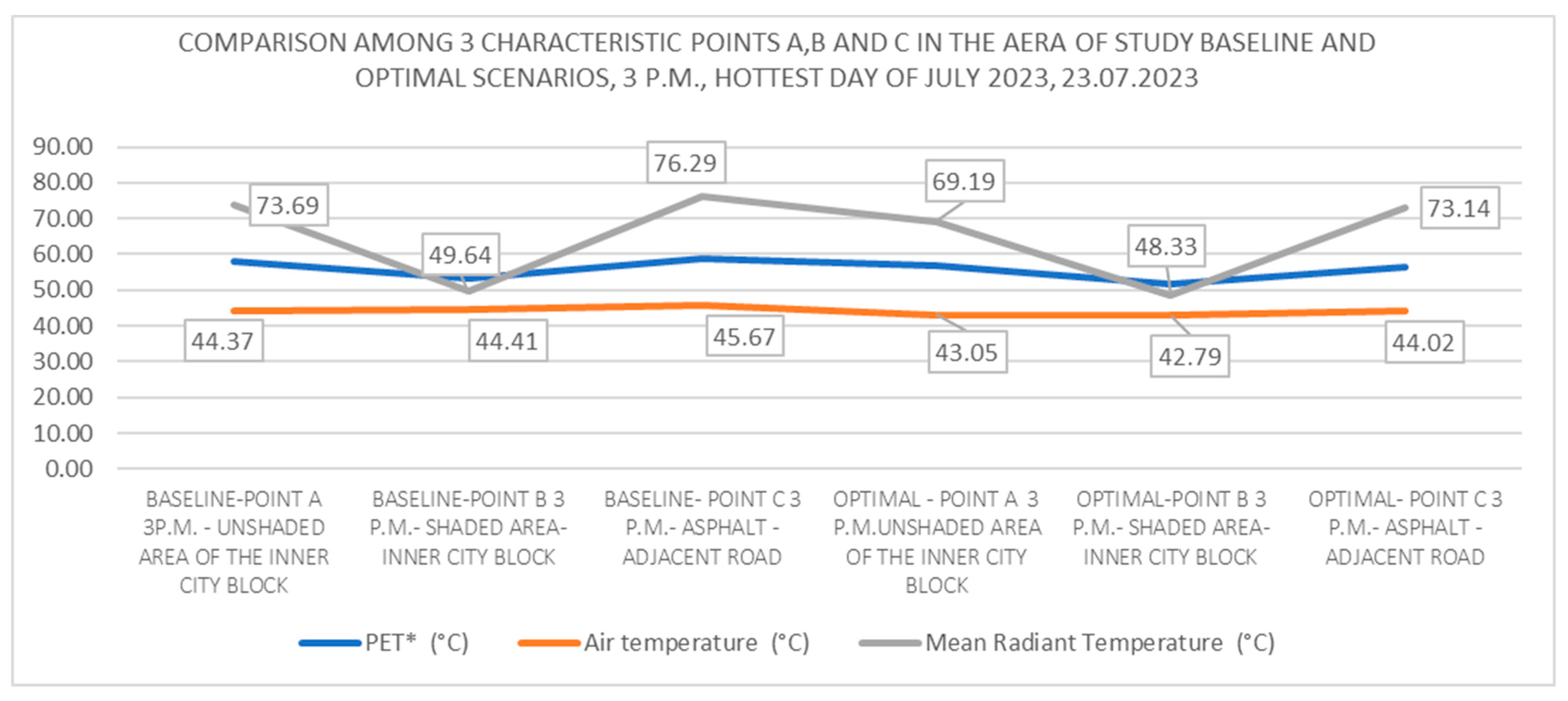
3.10.2. Optimal Scenario
- Point A saw the most pronounced improvement, with the PET dropping to 46.2 °C, indicating a reduction of 14.5 °C, largely attributed to dense tree shading and proximity to a newly added water feature.
- Point B reached a PET of 43.7 °C, marking a PET drop of 12.5 °C, resulting from added vegetation, increased soil permeability, and canopy coverage.
- Point C demonstrated a moderate reduction, with the PET reduced to 47.8 °C, representing an 11.1 °C decrease, aided by strategic tree placement and improved shading along the street corridor.
4. Discussion
5. Conclusions
Author Contributions
Funding
Data Availability Statement
Acknowledgments
Conflicts of Interest
References
- Mahmoud, I.H.; de Oliveira, F.L.; Morello, E.; Geneletti, D. Nature-based Solutions for Sustainable Urban Planning. In Greening Cities, Shaping Cities; Springer: Cham, Switzerland, 2022. [Google Scholar] [CrossRef]
- Tousi, E.; Tseliou, A.; Mela, A.; Sinou, M.; Kanetaki, Z. Exploring Thermal Discomfort during Mediterranean Heatwaves through Softscape and Hardscape ENVI-Met Simulation Scenarios. Sustainability 2024, 16, 6240. [Google Scholar] [CrossRef]
- Battisti, A.; Laureti, F.; Zinzi, M.; Volpicelli, G. Climate mitigation and adaptation strategies for roofs and pavements: A case study at Sapienza University Campus. Sustainability 2018, 10, 3788. [Google Scholar] [CrossRef]
- Sylliris, N.; Papagiannakis, A.; Vartholomaios, A. Improving the Climate Resilience of Urban Road Networks: A Simulation of Microclimate and Air Quality Interventions in a Typology of Streets in Thessaloniki Historic Centre. Land 2023, 12, 414. [Google Scholar] [CrossRef]
- Piselli, C.; Castaldo, V.L.; Pigliautile, I.; Pisello, A.L.; Cotana, F. Outdoor comfort conditions in urban areas: On citizens’ perspective about microclimate mitigation of urban transit areas. Sustain. Cities Soc. 2018, 39, 16–36. [Google Scholar] [CrossRef]
- Mela, A.; Tousi, E.; Melas, E.; Varelidis, G. Spatial Distribution and Quality of Urban Public Spaces in the Attica Region (Greece) during the COVID-19 Pandemic: A Survey-Based Analysis. Urban Sci. 2023, 8, 2. [Google Scholar] [CrossRef]
- Mela, A.; Tousi, E.; Varelidis, G. Assessing Urban Public Space Quality: A Short Questionnaire Approach. Urban Sci. 2025, 9, 56. [Google Scholar] [CrossRef]
- Chen, L.; Liu, L.; Wu, H.; Peng, Z.; Sun, Z. Change of Residents’ Attitudes and Behaviors toward Urban Green Space Pre- and Post- COVID-19 Pandemic. Land 2022, 11, 1051. [Google Scholar] [CrossRef]
- Eady, A.; Dreyer, B.; Hey, B.; Riemer, M.; Wilson, A. Reducing the risks of extreme heat for seniors: Communicating risks and building resilience. Health Promot. Chronic Dis. Prev. Can. 2020, 40, 215–224. [Google Scholar] [CrossRef]
- Tousi, E.; Mela, A. Supralocal Role of medium to large scale Urban Parks, in Attica Greece. Issues of meso car dependence during the COVID-19 Pandemic. (pending publication 2023–2024). J. Sustain. Archit. Civ. Eng. 2024, 2, 201–215. [Google Scholar] [CrossRef]
- Ferguson, K.T.; Evans, G.W. The built environment and mental health. In Encyclopedia of Environmental Health; Elsevier: Amsterdam, The Netherlands, 2019; Volume 80, pp. 465–469. [Google Scholar] [CrossRef]
- Moura, F.; Cambra, P.; Gonçalves, A.B. Measuring walkability for distinct pedestrian groups with a participatory assessment method: A case study in Lisbon. Landsc. Urban Plan. 2017, 157, 282–296. [Google Scholar] [CrossRef]
- Zysk, E.; Zalewska, K. The Methodology for Assessing the 15 Minute Age-Friendly Walkability (AFW) of Urban Public Spaces. Sustainability 2024, 16, 6406. [Google Scholar] [CrossRef]
- Mela, A.; Tousi, E. Safe and Inclusive Urban Public Spaces: A Gendered Perspective. The Case of Attica’s Public Spaces During the COVID-19 Pandemic in Greece. J. Sustain. Archit. Civ. Eng. 2023, 2, 5–14. [Google Scholar] [CrossRef]
- Sobouti, H.; Alavi, P. Evaluation of Quality Elderly of Public Open Spaces for the Case Study: (Sheet-e- Bazaar in Zanjan). Int. J. Archit. Urban Dev. 2017, 7, 47–56. [Google Scholar]
- Ebi, K.L.; Vanos, J.; Baldwin, J.W.; Bell, J.E.; Hondula, D.M.; Errett, N.A.; Hayes, K.; Reid, C.E.; Saha, S.; Spector, J.; et al. Extreme Weather and Climate Change: Population Health and Health System Implications. Annu. Rev. Public Health 2020, 42, 293–315. [Google Scholar] [CrossRef]
- Kovats, R.S.; Hajat, S. Heat stress and public health: A critical review. Annu. Rev. Public Health 2008, 29, 41–55. [Google Scholar] [CrossRef] [PubMed]
- Wang, W.; Zhou, W.; Ng, E.Y.Y.; Xu, Y. Urban heat islands in Hong Kong: Statistical modeling and trend detection. Nat. Hazards 2016, 83, 885–907. [Google Scholar] [CrossRef]
- Kenny, G.P.; Yardley, J.; Brown, C.; Sigal, R.J.; Jay, O. Heat stress in older individuals and patients with common chronic diseases. Can. Med. Assoc. J. 2010, 182, 1053–1060. [Google Scholar] [CrossRef] [PubMed]
- Kenney, W.L.; Craighead, D.H.; Alexander, L.M. Heat waves aging and human cardiovascular health. Med. Sci. Sports Exerc. 2014, 46, 1891–1899. [Google Scholar] [CrossRef]
- Yardley, J.E.; Stapleton, J.M.; Sigal, R.J.; Kenny, G.P. Do heat events pose a greater health risk for individuals with type 2 diabetes? Diabetes Technol. Ther. 2013, 15, 520–529. [Google Scholar] [CrossRef]
- Wee, J.; Tan, X.R.; Gunther, S.H.; Ihsan, M.; Leow, M.K.S.; Tan, D.S.Y.; Eriksson, J.G.; Lee, J.K.W. Effects of Medications on Heat Loss Capacity in Chronic Disease Patients: Health Implications Amidst Global Warming. Pharmacol. Rev. 2023, 75, 1140–1166. [Google Scholar] [CrossRef]
- Malmquist, A.; Hjerpe, M.; Glaas, E.; Karlsson, H.; Lassi, T. Elderly People’s Perceptions of Heat Stress and Adaptation to Heat: An Interview Study. Int. J. Environ. Res. Public Health 2022, 19, 3775. [Google Scholar] [CrossRef] [PubMed]
- Ozdemir, E.; Koukoufikis, G. The Persistence of Energy Poverty in the EU; Publications Office of the European Union: Luxembourg, 2024; Volume 41. [Google Scholar]
- Joshi, K.; Khan, A.; Anand, P.; Sen, J. Understanding the synergy between heat waves and the built environment: A three-decade systematic review informing policies for mitigating urban heat island in cities. Sustain. Earth Rev. 2024, 7, 25. [Google Scholar] [CrossRef]
- Hien, W.N.; Kardinaljusuf, S.; Samsudin, R.; Eliza, A.; Ignatius, M. A climatic responsive urban planning model for high density city: Singapore’s commercial district. Int. J. Sustain. Build. Technol. Urban Dev. 2011, 2, 323–330. [Google Scholar] [CrossRef]
- Fernandez Milan, B.; Creutzig, F. Reducing urban heat wave risk in the 21st century. Curr. Opin. Environ. Sustain. 2015, 14, 221–231. [Google Scholar] [CrossRef]
- Ingole, V.; Sheridan, S.C.; Juvekar, S.; Achebak, H.; Moraga, P. Mortality risk attributable to high and low ambient temperature in Pune city, India: A time series analysis from 2004 to 2012. Environ. Res. 2022, 204, 112304. [Google Scholar] [CrossRef] [PubMed]
- Kent, E. Leading urban change with people powered public spaces. The history, and new directions, of the Placemaking movement. J. Public Space 2019, 4, 127–134. [Google Scholar] [CrossRef]
- The World Bank. Piloting Nature-based Solutions for Urban Cooling. The World Bank. 2022. Available online: https://www.thegpsc.org/sites/gpsc/files/1._overview_piloting_nba_urban_cooling-compressed.pdf (accessed on 15 January 2025).
- Almeida, M.F. Age-Friendly Walkable Urban Spaces: A Participatory Assessment Tool Age-Friendly Walkable Urban Spaces: A Participatory. J. Hous. Elder. 2017, 30, 396–411. [Google Scholar] [CrossRef]
- Shirazi, M.R. Mapping neighbourhood outdoor activities: Space, time, gender and age. J. Urban Des. 2019, 24, 715–737. [Google Scholar] [CrossRef]
- Gómez, F.; Cueva, A.P.; Valcuende, M.; Matzarakis, A. Research on ecological design to enhance comfort in open spaces of a city (Valencia, Spain). Utility of the physiological equivalent temperature (PET). Ecol. Eng. 2013, 57, 27–39. [Google Scholar] [CrossRef]
- Matzarakis, A.; Amelung, B. Seasonal Forecasts, Climatic Change and Human Health; Springer: Dordrecht, The Netherlands, 2008. [Google Scholar] [CrossRef]
- Nouri, A.S.; Charalampopoulos, I.; Matzarakis, A. The application of the physiologically equivalent temperature to determine impacts of locally defined extreme heat events within vulnerable dwellings during the 2020 summer in Ankara. Sustain. Cities Soc. 2022, 81, 103833. [Google Scholar] [CrossRef]
- Deb, C.; Alur, R. The significance of Physiological Equivalent Temperature (PET) in outdoor thermal comfort studies. Int. J. Eng. Sci. Technol. 2010, 2, 2825–2828. [Google Scholar]
- Galluzo, L.; Borin, A. Post-pandemic Scenarios and Design Strategies for Public Space Transformation. Inmaterial 2021, 6, 72–87. [Google Scholar] [CrossRef]
- Jänicke, B.; Meier, F.; Hoelscher, M.T.; Scherer, D. Evaluating the effects of façade greening on human bioclimate in a complex Urban environment. Adv. Meteorol. 2015, 2015, 747259. [Google Scholar] [CrossRef]
- Jänicke, B.; Milošević, D.; Manavvi, S. Review of user-friendly models to improve the urban micro-climate. Atmosphere 2021, 12, 1291. [Google Scholar] [CrossRef]
- Gatto, E.; Ippolito, F.; Rispoli, G.; Carlo, O.S.; Santiago, J.L.; Aarrevaara, E.; Emmanuel, R.; Buccolieri, R. Analysis of urban greening scenarios for improving outdoor thermal comfort in neighbourhoods of lecce (Southern Italy). Climate 2021, 9, 116. [Google Scholar] [CrossRef]
- Tseliou, A.; Koletsis, I.; Pantavou, K.; Thoma, E.; Lykoudis, S.; Tsiros, I.X. Evaluating the effects of different mitigation strategies on the warm thermal environment of an urban square in Athens, Greece. Urban Clim. 2022, 44, 101217. [Google Scholar] [CrossRef]
- Elwy, I.; Ibrahim, Y.; Fahmy, M.; Mahdy, M. Outdoor microclimatic validation for hybrid simulation workflow in hot arid climates against ENVI-met and field measurements. Energy Procedia 2018, 153, 29–34. [Google Scholar] [CrossRef]
- Steffan, I.T.; De Salvatore, A.; Matone, F. Improving Accessibility and Usability in the Built Environment. Case Study: Guide Lines by the Lombardy Region, Italy. Stud. Health Technol. Inform. 2022, 297, 280–287. [Google Scholar] [CrossRef]
- Noël, C.; Rodriguez-Loureiro, L.; Vanroelen, C.; Gadeyne, S. Perceived Health Impact and Usage of Public Green Spaces in Brussels’ Metropolitan Area During the COVID-19 Epidemic. Front. Sustain. Cities 2021, 3, 668443. [Google Scholar] [CrossRef]
- Russo, A.; Cirella, G.T. Modern compact cities: How much greenery do we need? Int. J. Environ. Res. Public Health 2018, 15, 2180. [Google Scholar] [CrossRef]
- Dushkova, D.; Ignatieva, M.; Hughes, M.; Konstantinova, A.; Vasenev, V.; Dovletyarova, E. Human Dimensions of Urban Blue and Green Infrastructure during a Pandemic. Case Study of Moscow (Russia) and Perth (Australia). Sustainability 2021, 13, 4148. [Google Scholar] [CrossRef]
- Laureti, F.; Martinelli, L.; Battisti, A. Assessment and mitigation strategies to counteract overheating in urban historical areas in Rome. Climate 2018, 6, 18. [Google Scholar] [CrossRef]
- Koletsis, I.; Tseliou, A.; Lykoudis, S.; Pantavou, K.; Tsiros, I. Testing and validation of ENVI-met simulations based on in-situ micrometeorological measurements: The case of Syntagma square, Athens, Greece. In Proceedings of the 16th International Conference on Environmental Science and Technology, Rhodes, Greece, 4–7 September 2019; Volume 16, pp. 1–2. [Google Scholar] [CrossRef]
- Pantavou, K.; Santamouris, M.; Asimakopoulos, D.; Theoharatos, G. Empirical calibration of thermal indices in an urban outdoor Mediterranean environment. Build. Environ. 2014, 80, 283–292. [Google Scholar] [CrossRef]
- Tsiros, I.X.; Hoffman, M.E. Thermal and comfort conditions in a semi-closed rear wooded garden and its adjacent semi-open spaces in a mediterranean climate (athens) during summer. Archit. Sci. Rev. 2014, 57, 63–82. [Google Scholar] [CrossRef]
- Tousi, E.; Sinou, M.; Perouli, A. Urban Acupuncture As a Method of Open Space Regeneration in Greek Ex-refugee Areas. The Case of Nikea, Piraeus. J. Sustain. Archit. Civ. Eng. 2022, 30, 5–18. [Google Scholar] [CrossRef]
- Toussi Evgenia. Initial Planning and Current Situation of Refugee Housing and Outdoor Public Spaces in the Post-Refugee Urban Settlement of Nikea in Attica. Athens Social Atlas. 2024. Available online: https://www.athenssocialatlas.gr/en/article/refugee-housing-and-outdoor-public-spaces-in-nikea/ (accessed on 15 January 2025).
- Tousi, E.; Mela, A.; Tseliou, A.; Theofili, E.; Varelidis, G. Elements of urban design to ameliorate urban heat island. In Proceedings of the International Conference on Changing Cities VI: Spatial, Design, Landscape, Heritage and Socio-Economic Dimensions, Island of Rhodes, Greece, 24–28 June 2024; p. 5765. [Google Scholar]
- Tousi, E. Changing Socio-Spatial Identities. The case of the Asia Minor Refugee Urban Settlements in the Greater Athens-Piraeus Region in Greece. J. Sustain. Archit. Civ. Eng. 2024, 35, 153–167. [Google Scholar] [CrossRef]
- Maloutas, T.; Spyrellis, S.N.; Inequality and Segregation in Athens: Maps and Data. Athens Social Atlas. 2019. Available online: https://www.athenssocialatlas.gr/en/article/inequality-and-segregation-in-athens/ (accessed on 15 January 2025).
- Τούση, Ε. ΧΩΡOΚOΙΝΩΝΙΚOΙ ΣΥΣΧΕΤΙΣΜOΙ-ΜΕΤAΣΧHΜAΤΙΣΜOΙ: AΠO ΤHΝ ΠΡOΣΦΥΓΙΚH ΕΓΚAΤAΣΤAΣH ΣΤH ΝΙΚAΙA ΣΤH ΣHΜΕΡΙΝH ΕΙΚOΝA. Γεωγραφίες 2013. Available online: https://ejournals.epublishing.ekt.gr/index.php/geographies/article/view/33241 (accessed on 15 January 2025).
- Tseliou, A.; Tsiros, I.X. Modeling urban microclimate to ameliorate thermal sensation conditions in outdoor areas in Athens (Greece). Build. Simul. 2016, 9, 251–267. [Google Scholar] [CrossRef]
- Matzarakis, A.; Mayer, H. Another kind of environmental stress: Thermal stress. WHO Newsl. 1996, 18, 7–10. [Google Scholar]
- Cohen, P.; Potchter, O.; Matzarakis, A. Human thermal perception of Coastal Mediterranean outdoor urban environments. Appl. Geogr. 2013, 37, 1–10. [Google Scholar] [CrossRef]
- Elmarakby, E.; Elkadi, H. Prioritising urban heat island mitigation interventions: Mapping a heat risk index. Sci. Total Environ. 2024, 948, 174927. [Google Scholar] [CrossRef]
- Su, W.; Zhang, L.; Chang, Q. Nature-based solutions for urban heat mitigation in historical and cultural block: The case of Beijing Old City. Build. Environ. 2022, 225, 109600. [Google Scholar] [CrossRef]
- Hayes, A.T.; Jandaghian, Z.; Lacasse, M.A.; Gaur, A.; Lu, H.; Laouadi, A.; Ge, H.; Wang, L. Nature-Based Solutions (NBSs) to Mitigate Urban Heat Island (UHI) Effects in Canadian Cities. Buildings 2022, 12, 925. [Google Scholar] [CrossRef]
- Zheng, Y.; Keeffe, G.; Mariotti, J. Nature-Based Solutions for Cooling in High-Density Neighbourhoods in Shenzhen: A Case Study of Baishizhou. Sustainability 2023, 15, 5509. [Google Scholar] [CrossRef]
- Mosca, F.; Sani, G.M.D.; Giachetta, A.; Perini, K. Nature-based solutions: Thermal comfort improvement and psychological wellbeing, a case study in Genoa, Italy. Sustainability 2021, 13, 11638. [Google Scholar] [CrossRef]
- Olivieri, F.; Sassenou, L.N.; Olivieri, L. Potential of Nature-Based Solutions to Diminish Urban Heat Island Effects and Improve Outdoor Thermal Comfort in Summer: Case Study of Matadero Madrid. Sustainability 2024, 16, 2778. [Google Scholar] [CrossRef]
- Tseliou, A.; Koletsis, I.; Thoma, E.; Proutsos, N.; Lykoudis, S.; Pantavou, K.; Tsiros, I.X. A model-based study on the impact of different tree configurations on the thermal conditions of an urban square. In Proceedings of the 17th International Conference on Environmental Science and Technology, Athens, Greece, 1–4 September 2021; Volume 17, pp. 5–9. [Google Scholar] [CrossRef]
- Louafi, S.; Abdou, S. Vegetation Effects on Urban Street Microclimate and Thermal Comfort during Overheated Period under Hot and Dry Climatic Conditions. J New Technol. Mater. 2016, 6, 87–94. [Google Scholar] [CrossRef]
- McKenna, Z.J.; Foster, J.; Atkins, W.C.; Belval, L.N.; Watso, J.C.; Jarrard, C.P.; Orth, B.D.; Crandall, C.G. Age alters the thermoregulatory responses to extreme heat exposure with accompanying activities of daily living. J. Appl. Physiol. 2023, 135, 445–455. [Google Scholar] [CrossRef]
- Wilson, M.M.G.; Morley, J.E. Invited review: Aging and energy balance. J. Appl. Physiol. 2003, 95, 1728–1736. [Google Scholar] [CrossRef]
- Tyrovolas, S.; Haro, J.M.; Mariolis, A.; Piscopo, S.; Valacchi, G.; Makri, K.; Zeimbekis, A.; Tyrovola, D.; Bountziouka, V.; Gotsis, E.; et al. The Role of Energy Balance in Successful Aging among Elderly Individuals: The Multinational MEDIS Study. J. Aging Health 2015, 27, 1375–1391. [Google Scholar] [CrossRef]
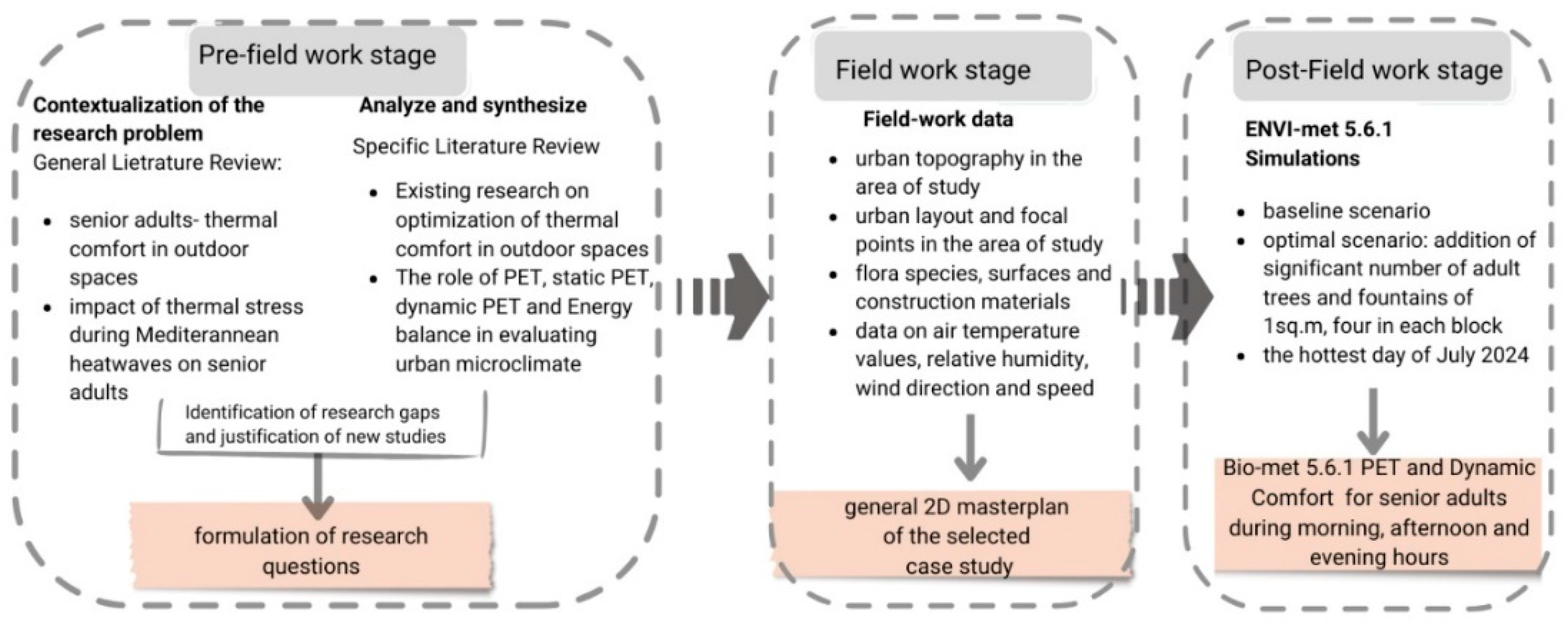
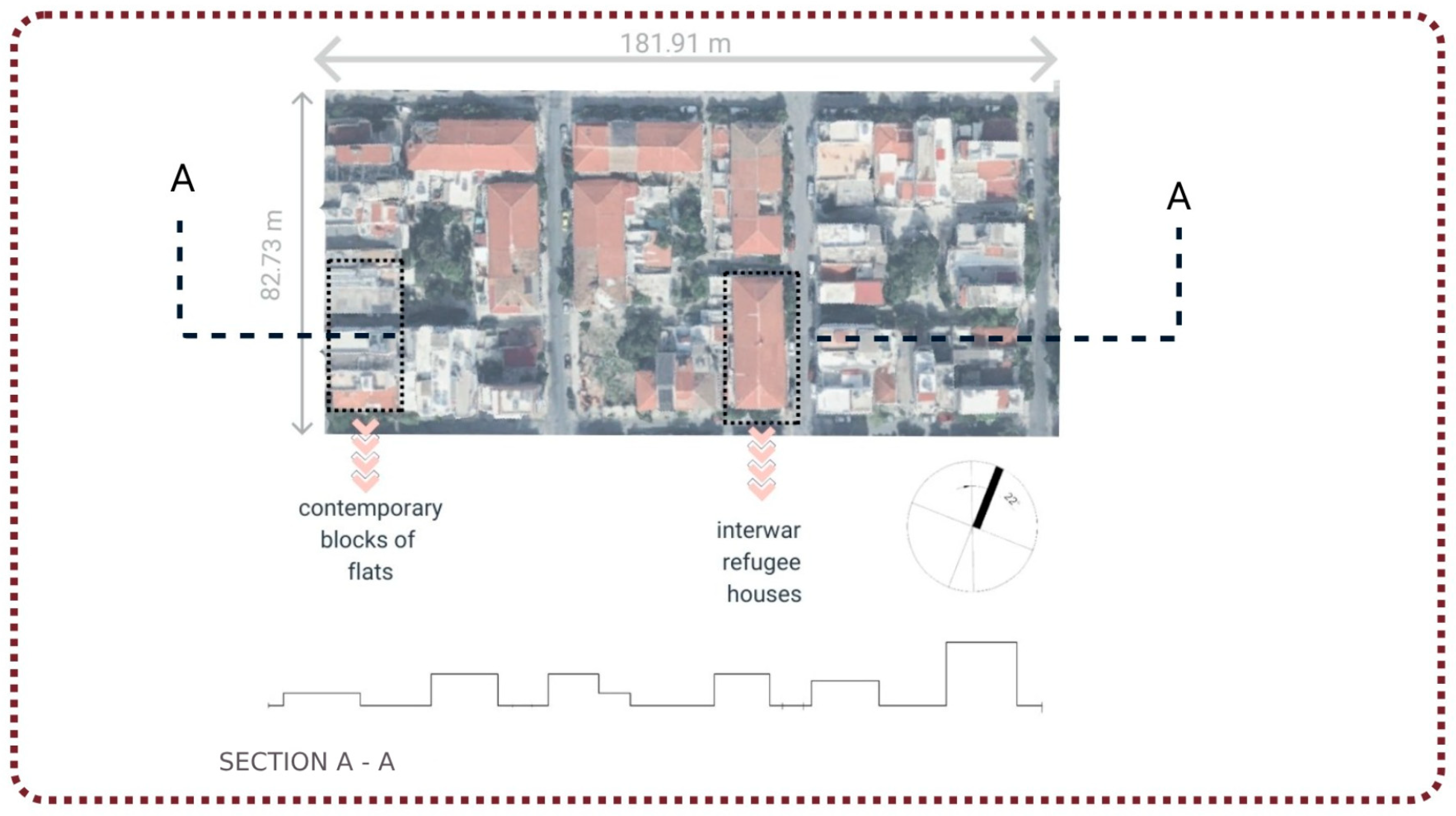

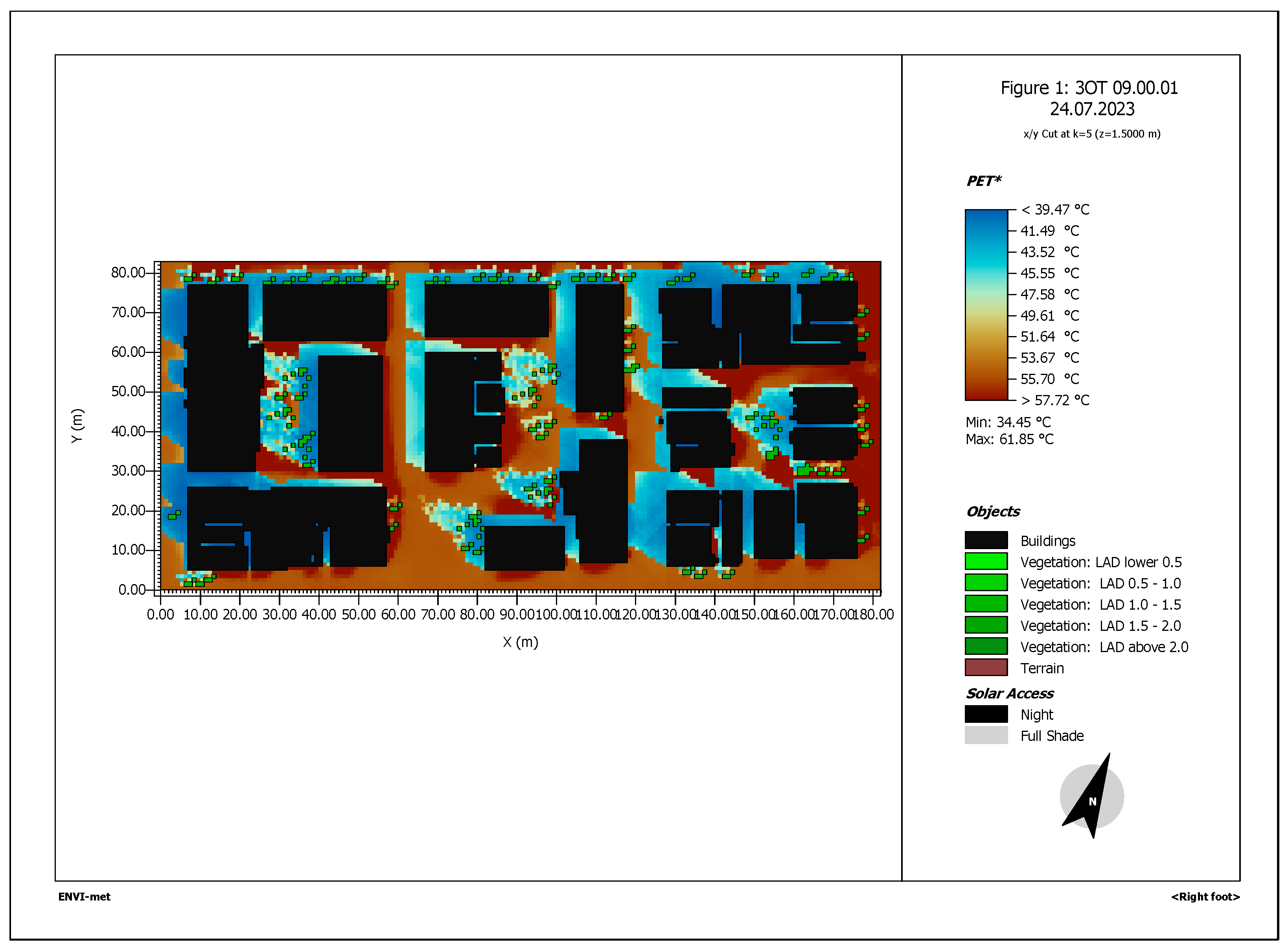

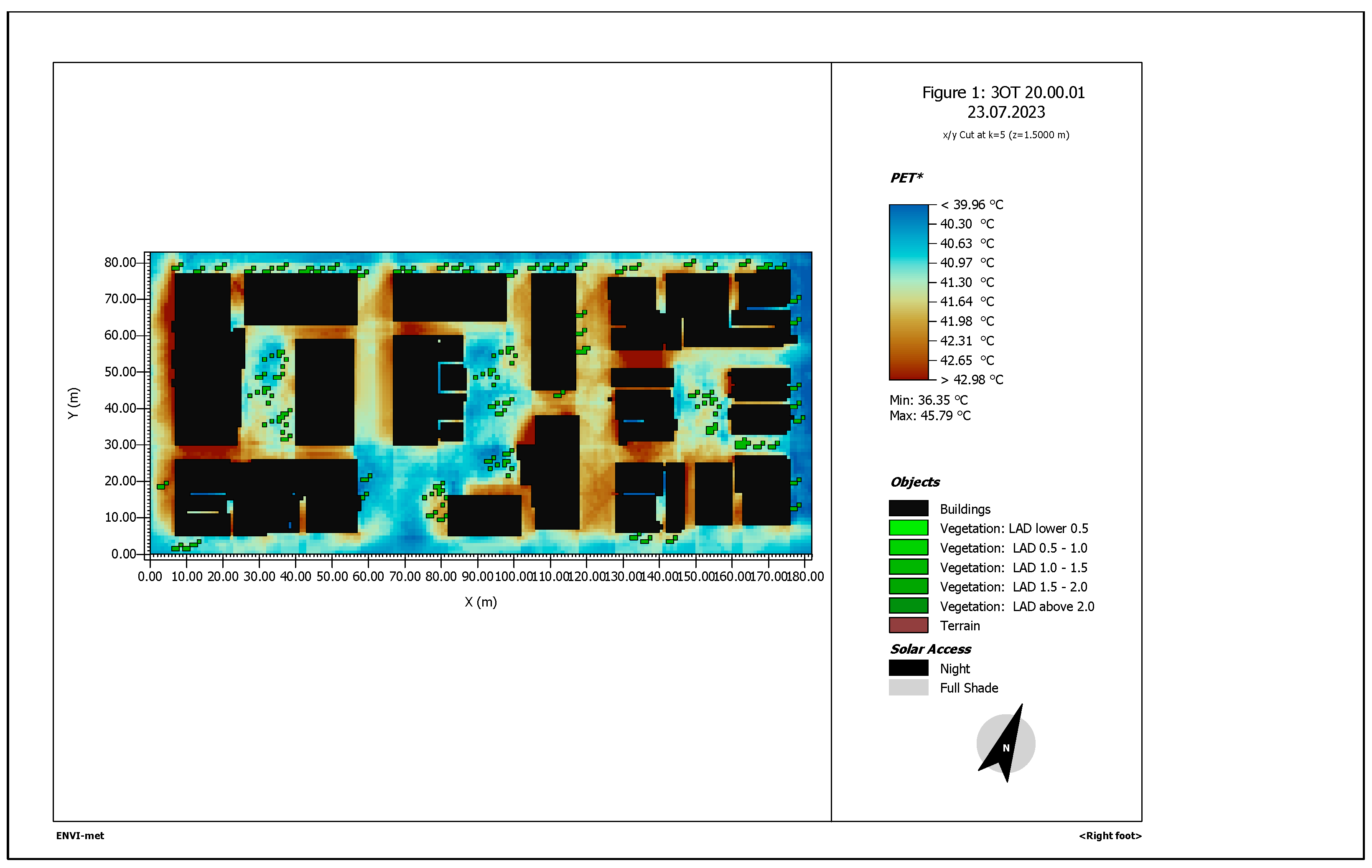
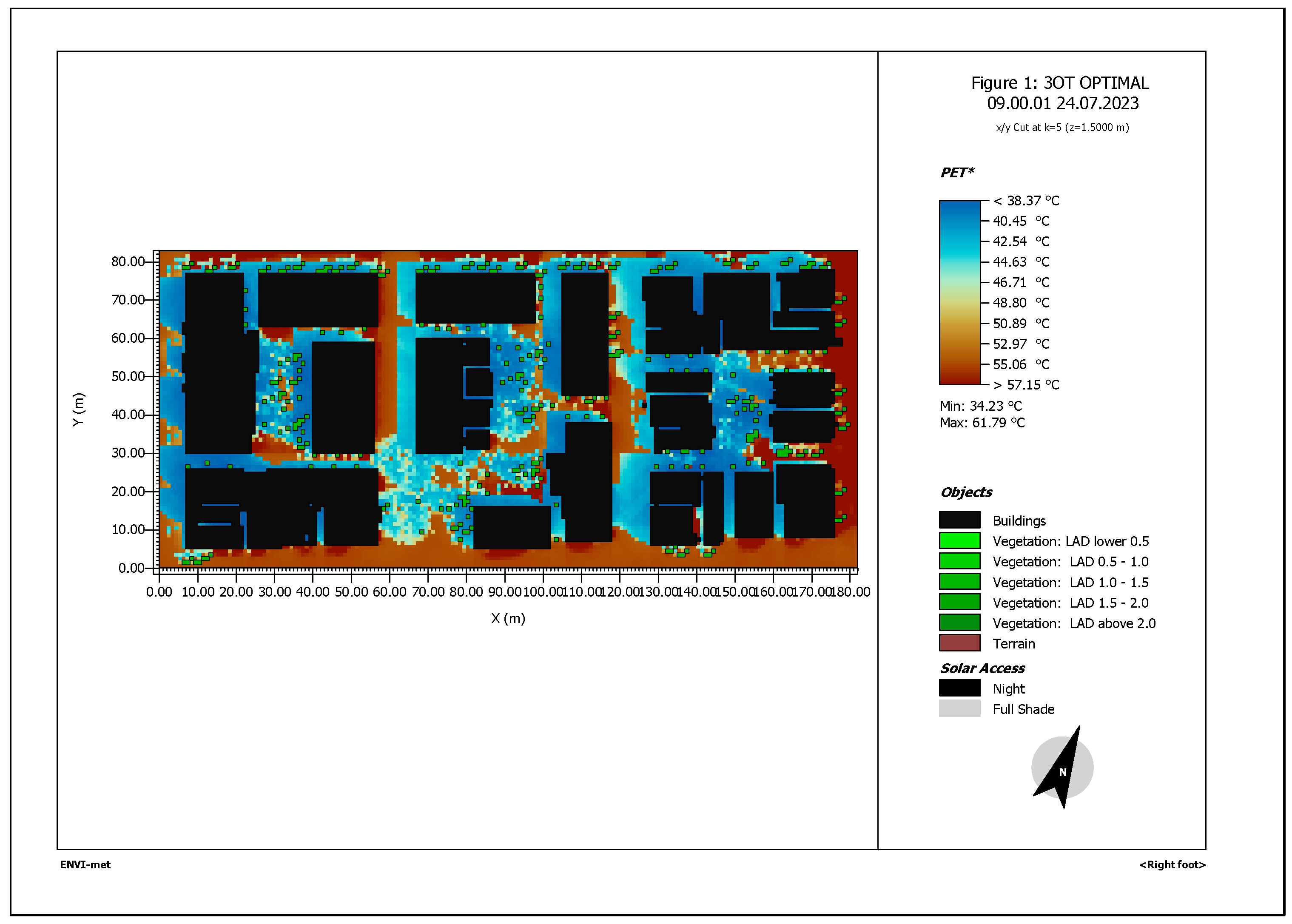



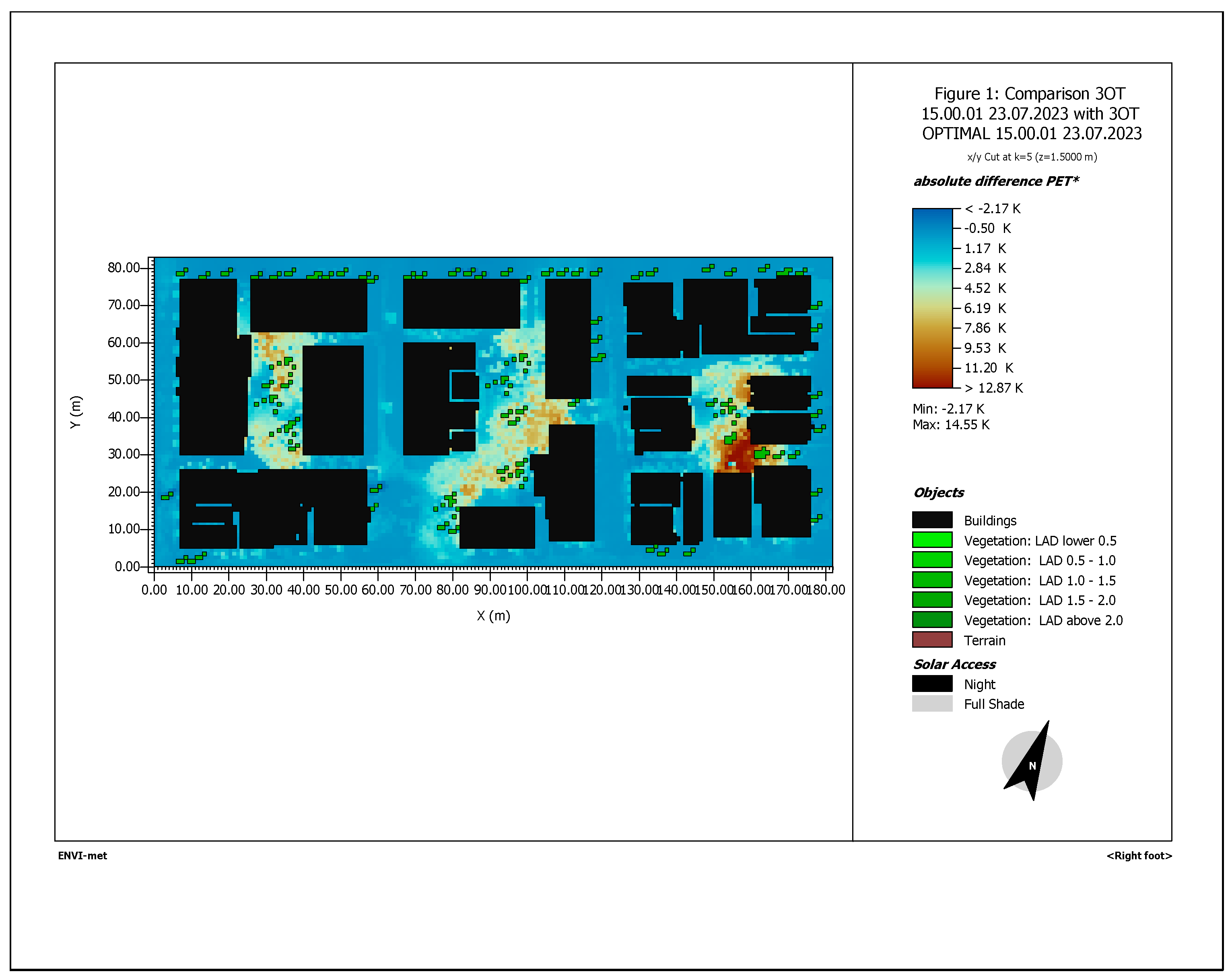
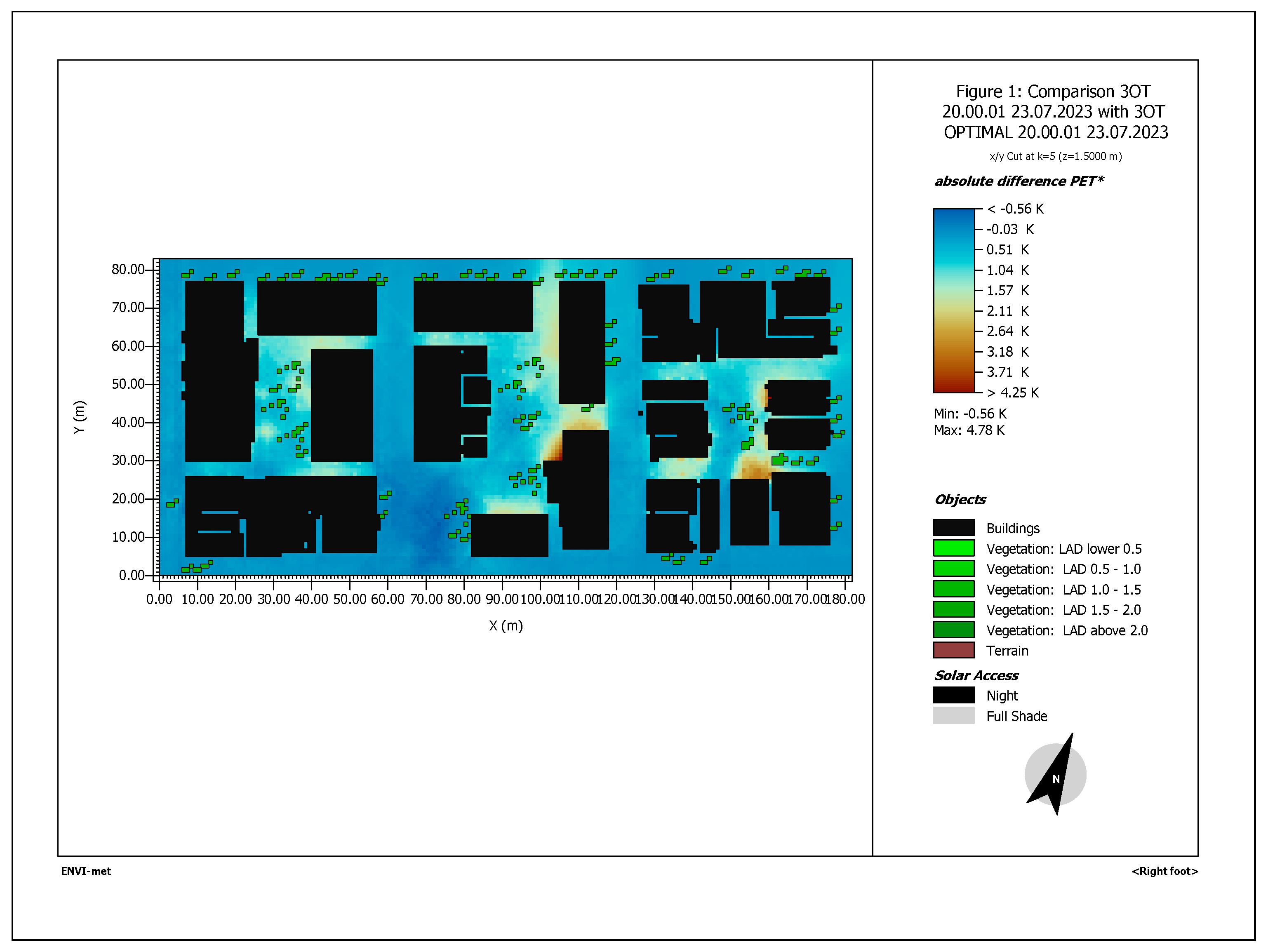
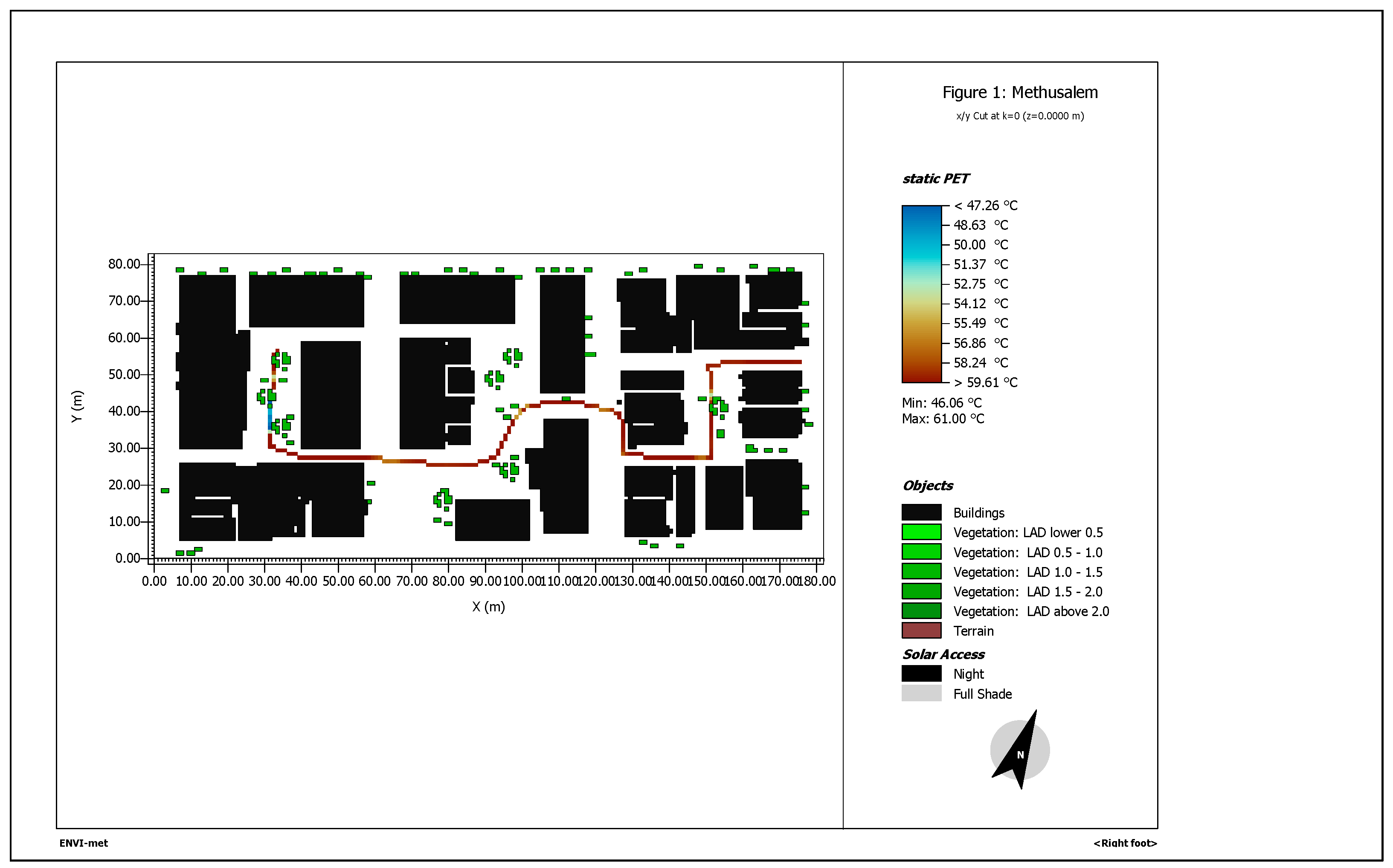
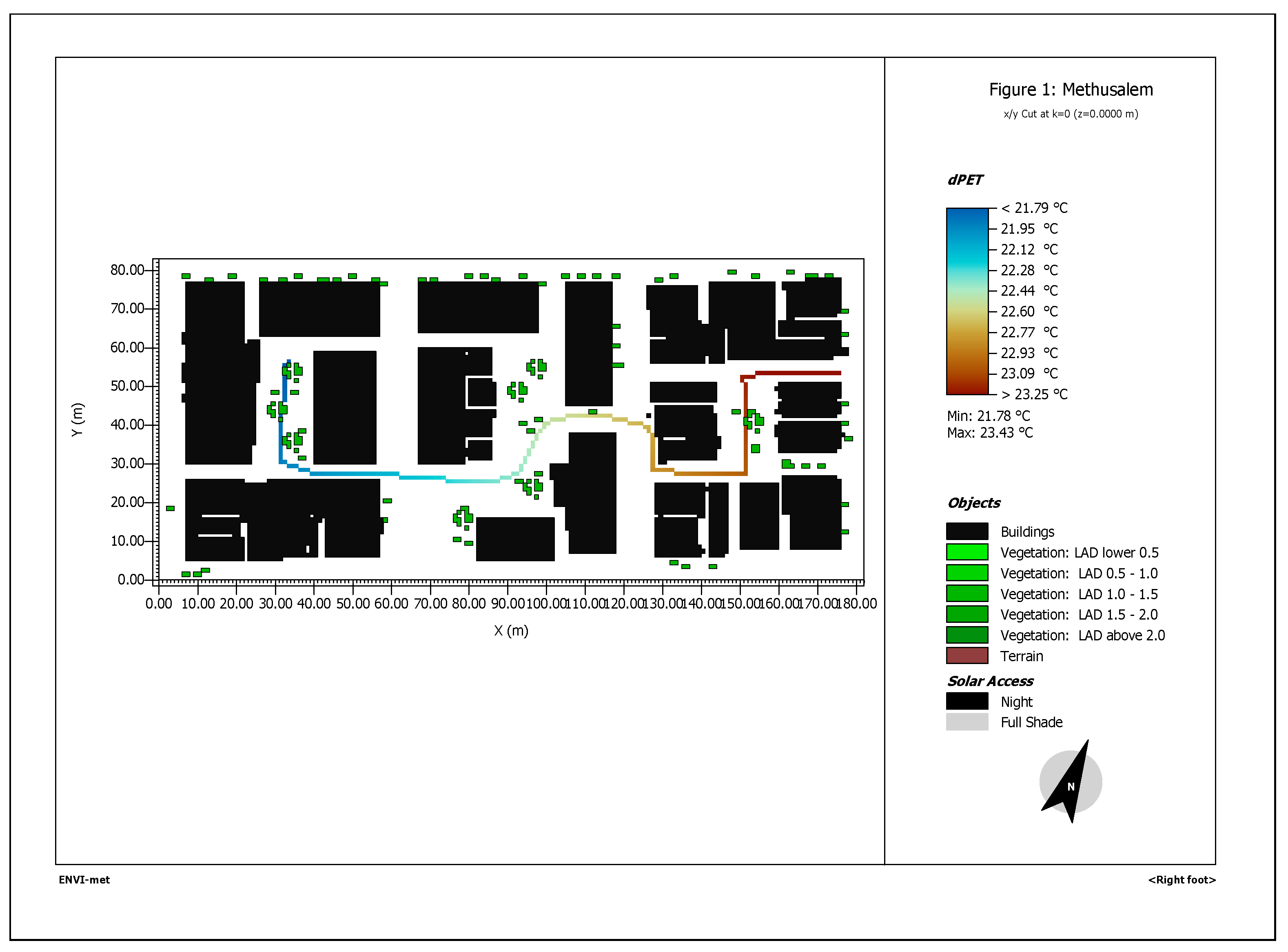

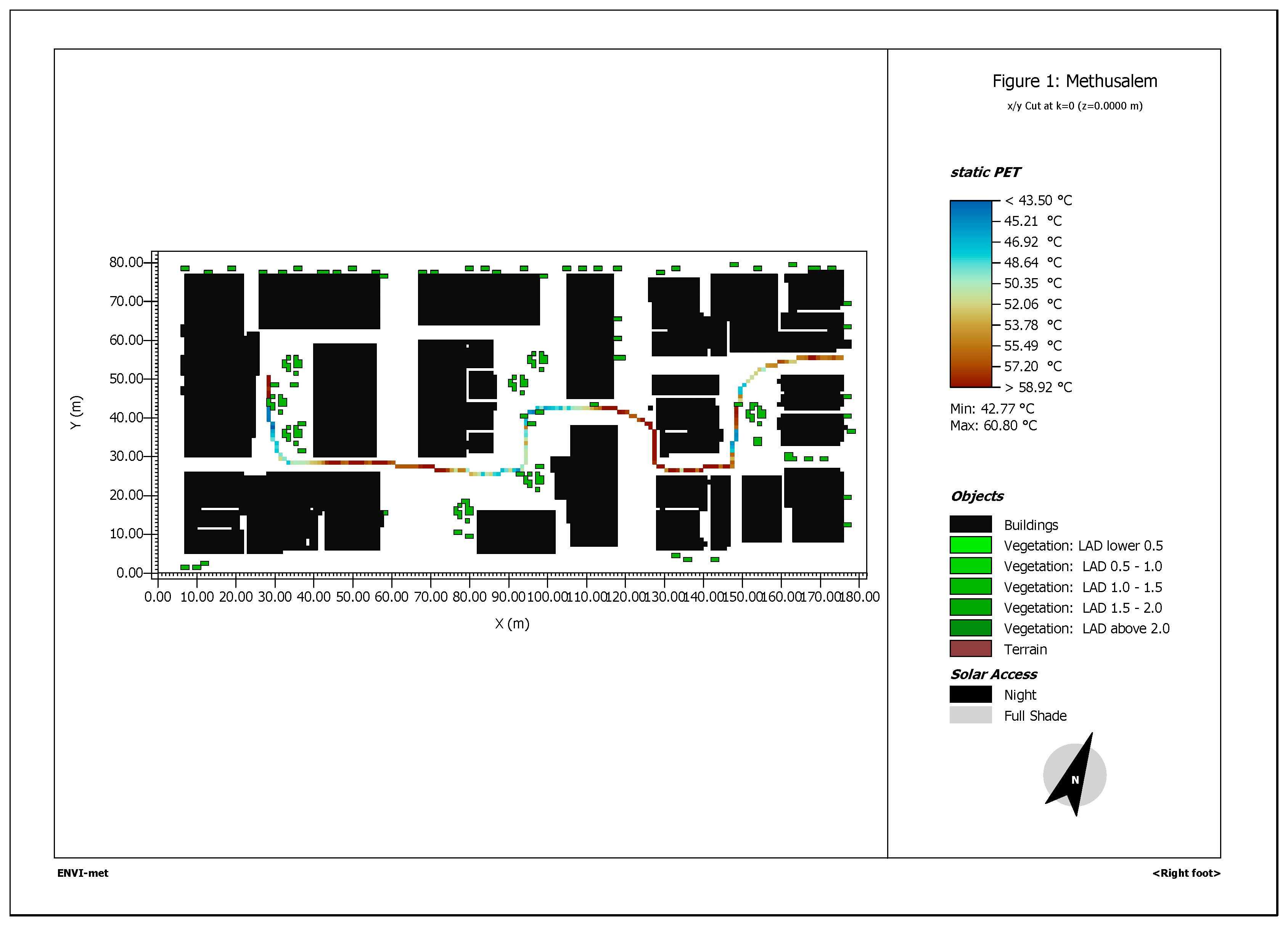
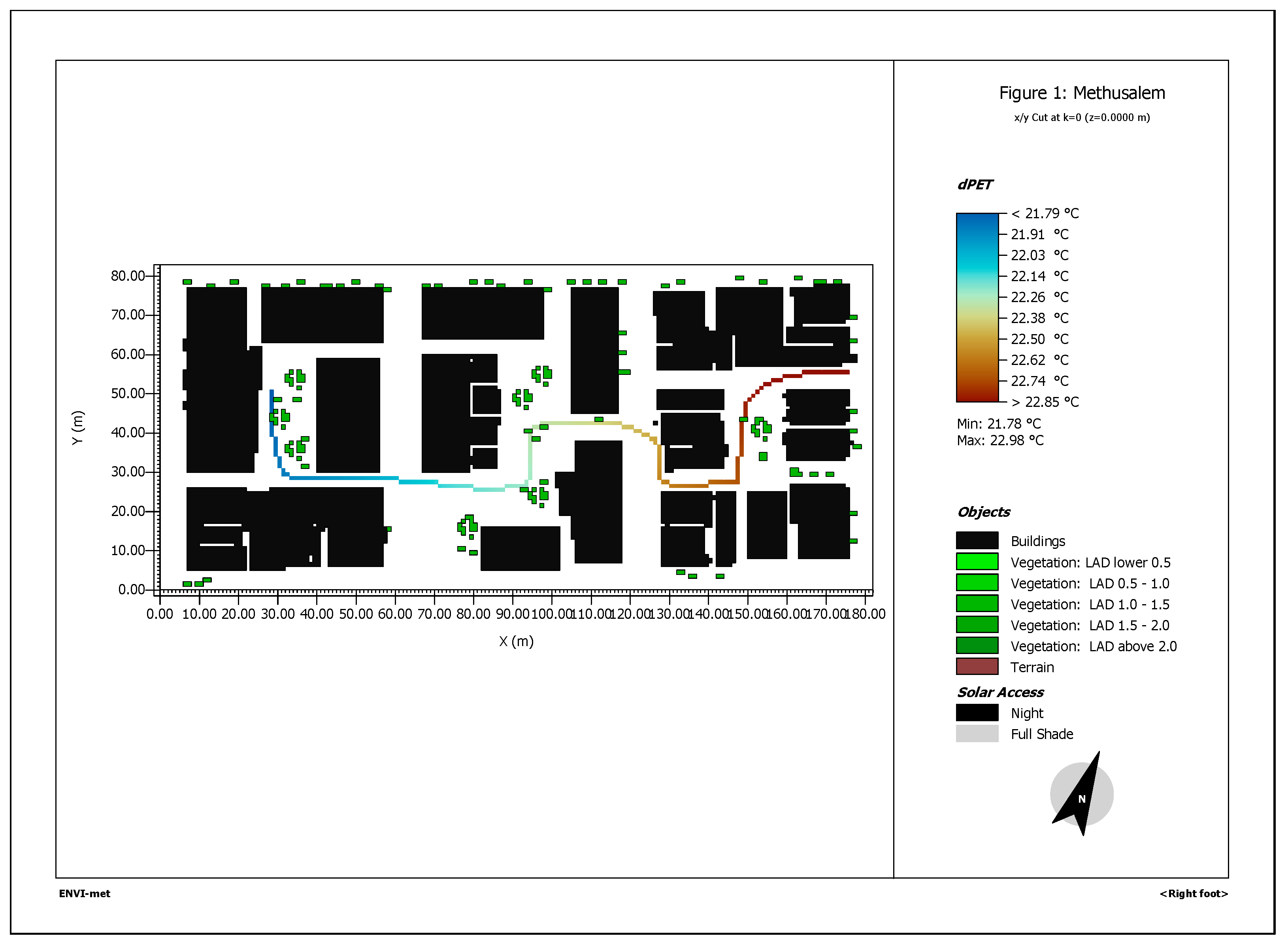
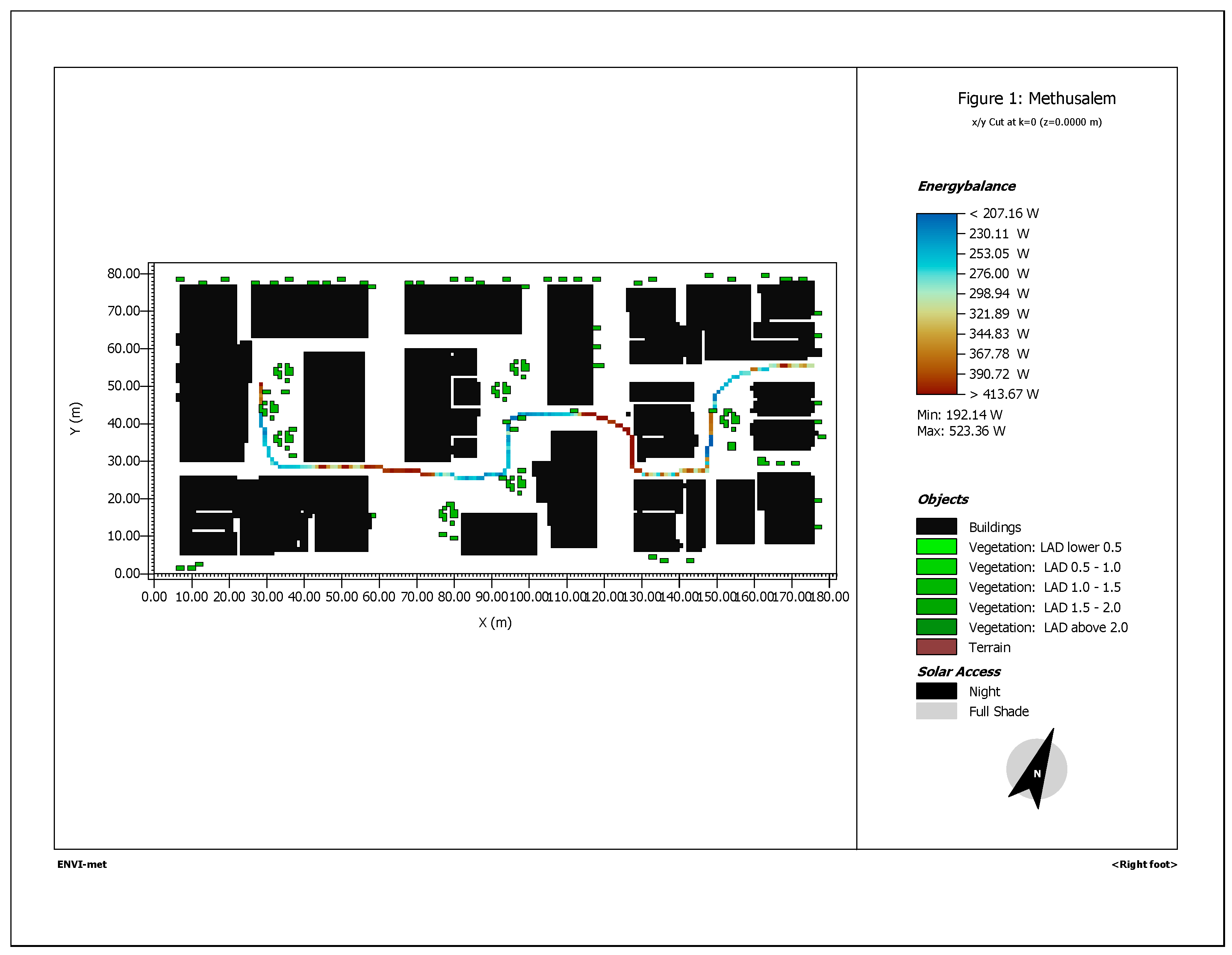
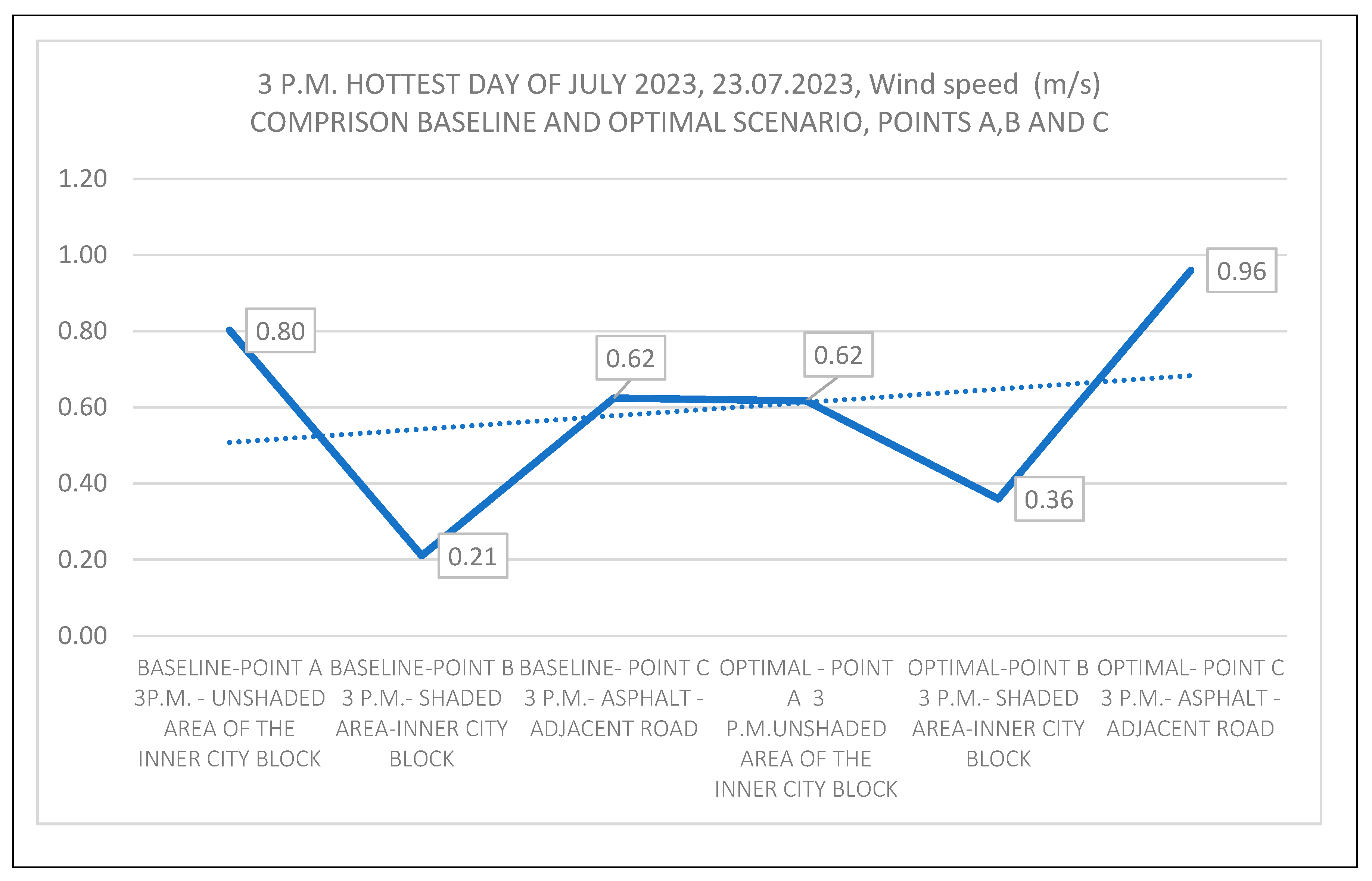

| Author(s) | Location/Context | Focus | Methods/Model | Key Findings |
|---|---|---|---|---|
| Laureti et al. (2018) [47] | Rome, Italy | Urban overheating mitigation in historic areas | ENVI-met, PET | Tree shading reduced PET by 8–12 °C; primary cooling via Tmrt reduction. |
| Tseliou et al. (2022) [41] | Athens, Greece | Tree configurations in an urban square | ENVI-met, PET | Dense tree canopies significantly lowered PET; supporting the use of optimal geometry. |
| Koletsis et al. (2019) [48] | Athens, Greece (Syntagma Sq.) | Validation of ENVI-met simulations | In situ vs. ENVI-met | High correlation found; ENVI-met accurately models Mediterranean microclimates. |
| Gatto et al. (2021) [40] | Lecce, Italy | Greening scenarios for thermal comfort improvement | ENVI-met, PET | Green infrastructure reduced PET up to 10 °C in southern Italian cities. |
| Pantavou et al. (2014) [49] | Athens, Greece | Calibration of thermal indices (e.g., PET, UTCI) | Field data, empirical model | PET performs well in Mediterranean outdoor spaces for evaluating heat stress. |
| Tsiros and Hoffman (2014) [50] | Athens, Greece (courtyards) | Semi-enclosed outdoor comfort in summer | Field measurements, PET | Garden spaces provided cooler PET values than adjacent open areas. |
| Battisti et al. (2018) [3] | Rome, Italy (University Campus) | Cooling strategies for roofs and pavements | ENVI-met | Shading had a greater PET reduction than cool pavements. |
| Gómez et al. (2013) [33] | Valencia, Spain | Ecological design for comfort in open urban spaces | PET | PET is suitable for evaluating design impacts on elderly populations. |
| Nouri et al. (2022) [35] | Ankara, Turkey | PET under extreme heat in vulnerable dwellings | PET, local extremes | Indoor PET correlated with outdoor stress; relevant for elderly individuals’ vulnerability. |
| Piselli et al. (2018) [5] | Perugia, Italy | Microclimate mitigation based on citizen perception | In situ monitoring, pedestrian surveys, ENVI-met | Vegetation increase was preferred by users and significantly improved thermal comfort in simulations; green solutions were most effective against anthropogenic heat. |
| Sylliris et al. (2023) [4] | Thessaloniki, Greece | Climate resilience and air quality on Mediterranean urban roads | ENVI-met, PET, air quality modeling | Pedestrianization with trees and cool materials reduced PET by up to 15 °C and NOx by 87%; green interventions were most effective in high-density zones. |
| Parameter | Value | Source/Notes |
|---|---|---|
| Simulation Date | 23 July 2023 | Hottest day of the year during the 2023 heatwave |
| Simulation Duration | 06:00 to 20:00 (14 h) | Covers full daytime exposure |
| Air Temperature (06:00) | 28.1 °C | Meteosearch.gr: Athens Station |
| Maximum Air Temperature | 42.3 °C (approx. 15:00) | Meteosearch.gr: Athens Station |
| Relative Humidity | 28–53% | Varies throughout the day |
| Wind Speed | 1.2 m/s | Measured at 10 m height |
| Wind Direction | North (0°) | Constant direction assumed |
| Relative Height (% of Tree Height) | LAD (m2/m3)—Cylindrical Canopy | LAD (m2/m3)—Heart-Shaped Canopy |
|---|---|---|
| 0–20% | 0.5 | 0.0 |
| 20–40% | 0.5 | 0.5 |
| 40–60% | 0.5 | 1.2 |
| 60–80% | 0.5 | 1.5 |
| 80–100% | 0.5 | 1.0 |
| Tree Canopy Type | Albedo | Transpiration Efficiency |
|---|---|---|
| Cylindrical Canopy | 0.20–0.25 | Moderate |
| Heart-Shaped Canopy | 0.20–0.25 | High |
| PET (°C). | Mediterranean Scale b | Thermal Comfort Assessment |
|---|---|---|
| Original Scale a | ||
| >41.1 | >40.0 | Very hot |
| 35.1 to 41.0 | 34.0 to 40.0 | Hot |
| 29.1 to 35.0 | 28.0 to 34.0 | Warm |
| 23.1 to 29.0 | 26.0 to 28.0 | Slightly warm |
| 18.1 to 23.0 | 19.0 to 26.0 | Neutral |
| 13.1 to 18.0 | 15.0 to 19.0 | Slightly cool |
| 8.1 to 13.0 | 12.0 to 15.0 | Cool |
| 4.1 to 8.0 | 8.0 to 12.0 | Cold |
| <4.0 | <8.0 | Very cold |
| Time of Day | Scenario | PET Range (°C) | Thermal Stress Category |
|---|---|---|---|
| 9:00 a.m. | Baseline | 34.45–61.85 | Hot to Very Hot |
| Optimal | 34.23–61.79 | Hot to Very Hot | |
| Difference in PET | −11.17 to 22.45 | Reduction evident in shaded areas | |
| 3:00 p.m. | Baseline | 38.14–62.39 | Hot to Very Hot |
| Optimal | 37.94–61.86 | Hot to Very Hot | |
| Difference in PET | 2.17–14.55 | Significant comfort improvement | |
| 8:00 p.m. | Baseline | 36.35–45.79 | Hot to Very Hot |
| Optimal | 36.36–44.67 | Hot to Very Hot | |
| Difference in PET | −0.56–4.78 | Modest improvement in thermal comfort |
| Intervention | Thermal Effectiveness | Feasibility in Dense Urban Areas | Policy and Planning Integration |
|---|---|---|---|
| Mature Tree Planting | High PET reduction (up to 14.5 °C during peak hours) | High—easily integrated into pavements, courtyards | Include in urban regeneration plans and long-term greening strategies for heat-prone neighborhoods |
| Fountain Installation | Moderate PET reduction via localized evaporative cooling | Medium—requires available open space and infrastructure | Recommend for central communal areas; coordinate with public space revitalization efforts |
| Optimized Tree Canopy Design (Height and Shape) | High—improves shading and microclimate regulation | High—applicable to both existing and new plantings | Adopt species selection standards prioritizing dense and elevated canopies |
| Spatial Planning for Elderly Activity | Indirect thermal benefit by maximizing shaded exposure | High—adaptable to local use patterns | Integrate into age-friendly urban design frameworks; target shading along common walking routes |
Disclaimer/Publisher’s Note: The statements, opinions and data contained in all publications are solely those of the individual author(s) and contributor(s) and not of MDPI and/or the editor(s). MDPI and/or the editor(s) disclaim responsibility for any injury to people or property resulting from any ideas, methods, instructions or products referred to in the content. |
© 2025 by the authors. Licensee MDPI, Basel, Switzerland. This article is an open access article distributed under the terms and conditions of the Creative Commons Attribution (CC BY) license (https://creativecommons.org/licenses/by/4.0/).
Share and Cite
Tousi, E.; Mela, A.; Tseliou, A. Nature-Based Urbanism for Enhancing Senior Citizens’ Outdoor Thermal Comfort in High-Density Mediterranean Cities: ENVI-met Findings. Urban Sci. 2025, 9, 152. https://doi.org/10.3390/urbansci9050152
Tousi E, Mela A, Tseliou A. Nature-Based Urbanism for Enhancing Senior Citizens’ Outdoor Thermal Comfort in High-Density Mediterranean Cities: ENVI-met Findings. Urban Science. 2025; 9(5):152. https://doi.org/10.3390/urbansci9050152
Chicago/Turabian StyleTousi, Evgenia, Athina Mela, and Areti Tseliou. 2025. "Nature-Based Urbanism for Enhancing Senior Citizens’ Outdoor Thermal Comfort in High-Density Mediterranean Cities: ENVI-met Findings" Urban Science 9, no. 5: 152. https://doi.org/10.3390/urbansci9050152
APA StyleTousi, E., Mela, A., & Tseliou, A. (2025). Nature-Based Urbanism for Enhancing Senior Citizens’ Outdoor Thermal Comfort in High-Density Mediterranean Cities: ENVI-met Findings. Urban Science, 9(5), 152. https://doi.org/10.3390/urbansci9050152









